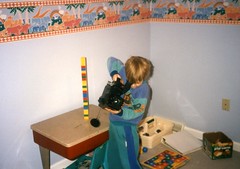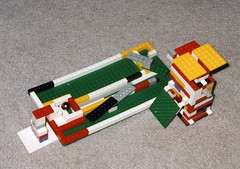I thought when I started my blog that my first focus would be the topic centered around my Homeschooling Creatively yahoo group. However, I wanted my blog to evolve naturally, so this is the first opportunity I have taken to really discuss this particular passion of mine. I was prompted to put some of my thoughts about learning differences from some comments on my post entitled, “When Waiting Isn’t Enough”.
I said:
As it pertains to the plethora of “school-created labels” such as ADD, ADHD, gifted, LD, etc., I think the biggest problem with school is that they blame the child instead of the system that doesn’t account for the child’s learning timeframe nor their learning style.
Steph of momof3feistykids at A Room of My Own said:
However, I feel that issues like learning disabilities and ADD are very real, and create challenges for a child whether he is in school or not.
First, I’m not saying things like inattentiveness, hyperactivity, high intelligence, and learning differences don’t exist. They do. What I’m saying is that these things can be part and parcel to someone’s personality and/or learning style type that bring great assets as well as challenges from time to time, particularly when the environment and expectations do not match these traits.
I am particularly passionate about the right-brained, visual-spatial, creative learner. What I have discovered about this learner are:
1) their learning style is not valued in our society (it values left-brained traits, which is the style of learning conducted in school for which we have all been conditioned to value as well),
2) they are one of the two most labeled children in schools (ADD, gifted, LD, and dyslexic are some of the school-created labels; Asperger’s Syndrome, high functioning autism, and sensory integration disorder are some “disorders” that often strongly resemble the traits of this learner),
3) they develop certain (left-brained valued) subjects later such as reading, handwriting, writing, spelling, and math computation (they are bested suited to learn these topics between the ages of 8-10 years of age),
4) they have a core attraction to one of the following: drawing, music, theater, dance, building things (like Legos), computers, or video games, and
5) they are misunderstood by school personnel and parents by having things said of them such as “they are smart, but lazy” and “they are not living up to their potential;” and in homeschools, they often resist your teaching and they are also apt to say, “this is stupid” to everything you suggest.AT&T’s campaign to reach out and touch someone made me reach out for a tissue – not a phone. try this link levitra no prescription
Inattentiveness is a strong component of this learning style when they are placed in an environment that does not enhance their strengths for attentiveness: toward things that interest them . . . particularly highly creative outlets! I believe strongly that dyslexia would all but disappear (mostly) if these learners were allowed to wait until 8-10 years old to begin to learn to read, and are started with a sight word program with pictures. Learning disabilities could not exist if these learners were allowed to pursue their strengths and gifts, which are not valued in our society. They need to be able to pursue their creative outlet at a young age, and also be exposed to pictures longer as they develop their extensive pictorial library of images that will be an asset to them as they tackle the symbolic nature of the left-brained tasks of reading or writing later.
Steph goes on to say:
Also, while the issues that go along with a diagnosis like Asperger’s Syndrome are not the same as those that accompany autism, they are pervasive and significant and require more intervention than simply creating an enriching environment and respecting the child’s inner timetable.
Well, let me give you two sides to this coin. Once a parent can recognize the learning style of their child with Asperger’s, which is highly likely to be this creative learner, and you provide that enriching environment that respects the child’s inner timetable and learning style, then I think the learning/academic part is a breeze!
Now, the flip side of this coin is the “living with” portion of this “high maintenance child”. They have strong social, behavioral, emotional, and sensorial needs that should be addressed in order to help their futures be bright. The beauty of homeschool is that we can create a holistic facilitation environment that not only tackles the academics, but includes these other all-important arenas. I call it a success-based, mentor-supported, skill-developing environment.
Now, an important aspect of facilitating in these areas is to recognize the two sides of the coin. For instance, it is common for a creative learner to be highly sensitive. I find these creative learners either meltdown (cry and fall in a heap) or burst out (anger and lash out). It is because they feel so deeply. This is essential to their creative expressions! To dance in a way that moves someone is to feel deeply and express it through dance. To paint something that stirs another is to feel deeply and it shows through the art. However, with this same asset comes places where it interferes with one’s life. This is where we need to help our children develop skills that manages this two-sided trait of strong emotion.
There is SOOOO much I could write about this learning style that two of my children in particular have taught me extensively about for which I have shared with others. For now, I will create a page with my outlines that I follow when I present workshops about this learner. One is about how they learn: “Understanding the Right-Brained Learner” and the other is about living with them: “Living with the Right-Brained Learner”.
I hope to talk about this learner many times on my blog 🙂



One response to “Learning Differences”